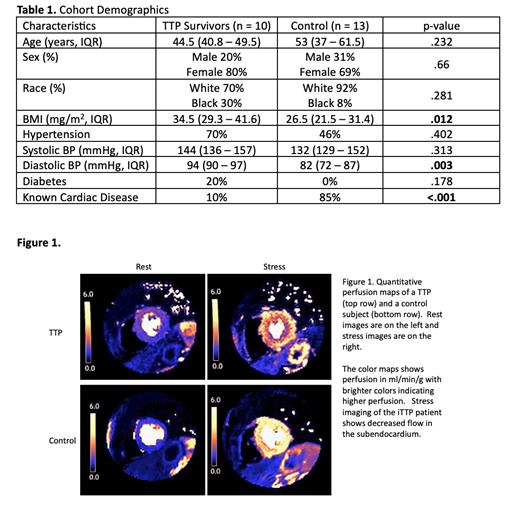Introduction: Thrombotic thrombocytopenic purpura (TTP) survivors have increased rates of cardiovascular morbidity and mortality when compared with the general population. In this prospective pilot study, we sought to further characterize the long-term cardiovascular sequelae of TTP survivors through pharmacologic stress cardiac magnetic resonance imaging (CMR). Stress CMR has been increasingly utilized to detect clinical and subclinical structural and functional changes. A CMR biomarker of myocardial remodeling is extracellular volume (ECV); an increase in ECV may indicate the development of interstitial myocardial fibrosis. ECV was chosen for structural assessment as it has been implicated with diastolic dysfunction and other cardiac issues in other hematologic diseases, like sickle cell anemia.
Methods: Adult patients (age ≥18 years of age) with TTP (immune-mediated or congenital) in the Ohio State University (OSU) TTP registry were prospectively consented and enrolled from March 2023 through July 2023 to undergo adenosine stress CMR at standard clinical dosing. All patients in the TTP cohort had confirmed diagnosis based on ADAMTS13 activity <15% during an acute episode and were in clinical remission at the time of CMR testing. Standard baseline and stress CMR parameters were obtained and compared with an age and sex matched control population, selected from patients without TTP who underwent identical stress CMR protocol for other indications and demonstrated normal stress perfusion. Patients in the control cohort predominantly had diagnoses of arrhythmia, stable angina, or heart failure. We collected data on patient demographics, details of TTP history, and underlying comorbidities. On CMR standard structural measurements were evaluated, and ECV was calculated (normal range 25.3 ± 3.5%). Perfusion was measured per standard protocols via global myocardial blood flow (MBF) as ml/min/g. Differences between the TTP and control populations were tested using the Fischer's exact test for categorical variables and Mann-Whitney U test for continuous variables.
Results: A total of 10 TTP patients (9 immune-mediated, 1 congenital) were enrolled between March and July 2023. Median age at enrollment was 44.5 years (IQR 40.8-49.5) and 80% (8/10) were female. Patients were in documented clinical and ADAMTS13 activity remission with median ADAMTS13 activity of 68% (64.0-84.5), excluding the activity level of the congenital patient. Median time from initial diagnosis was 15 years (range 0.5 - 41 years) and median number of acute TTP episodes was 2 (IQR 1.0-4.5). Characteristics of the study (n= 10) and control cohort (n = 13) are summarized in Table 1. There were no significant differences in the TTP and control cohorts with respect to age, sex, race, and presence of hypertension or diabetes. Patients in the TTP cohort had significantly higher BMI (median 34.5 mg/m 2 vs 26.5 mg/m 2, p = .012), diastolic blood pressure (94 mmHg vs 82 mmHg, p = .003), and a lower rate of known cardiac disease (10% vs 85%, p<.001).
Stress CMR showed reduced myocardial perfusion in TTP survivors:Nine out of 10 (90%) TTP survivors had evidence of structural or perfusion deficits on CMR. The median ECV in the TTP cohort (28.5%, 24.8 - 31.5) was increased compared with controls (26%, 23.5 - 27.5) though it did not reach significance (p = .08). There were no significant differences in median global MBF at rest in the TTP group (1.30, 1.16 - 1.37) compared with controls (1.18, 1.07 - 1.31, p = .210). However, TTP survivors had significantly reduced stress MBF (3.28, 2.21 - 3.53) vs controls (4.1, 3.88 - 4.22, p <.001) with adenosine. Reductions in quantitative stress perfusion in the TTP cohort was primarily noted in the subendocardium as shown in Figure 2.
Conclusion: Asymptomatic structural changes and reduction in quantitative perfusion are common in TTP survivors. The study is ongoing to recruit more patients to ensure clinical significance and generalizability of these preliminary findings. Stress CMR may detect subclinical myocardial damage in TTP survivors who otherwise do not exhibit overt cardiovascular symptoms until a later time and may provide the basis to understand increased cardiovascular morbidity and mortality in this population.
Disclosures
Sukumar:Sanofi Genzyme: Honoraria. Cataland:Takeda: Consultancy; Sanofi: Consultancy.


This feature is available to Subscribers Only
Sign In or Create an Account Close Modal